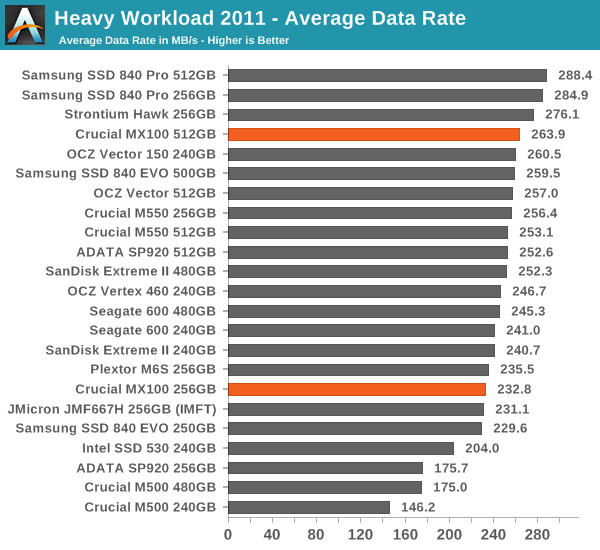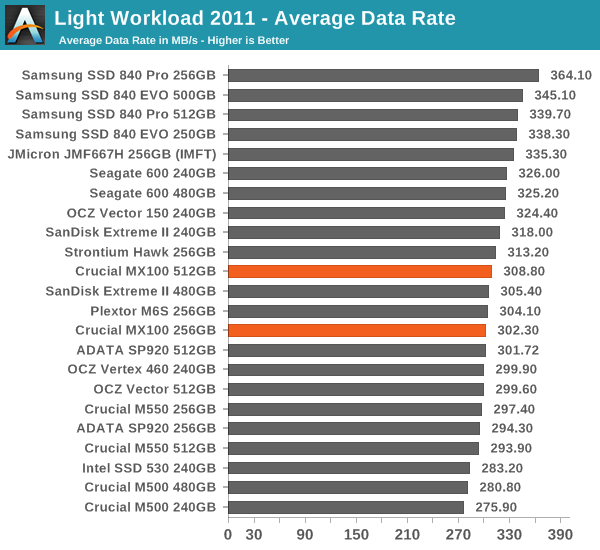Crucial MX100 (256GB & 512GB) Review
by Kristian Vättö on June 2, 2014 3:00 PM ESTAnandTech Storage Bench 2011
Back in 2011 (which seems like so long ago now!), we introduced our AnandTech Storage Bench, a suite of benchmarks that took traces of real OS/application usage and played them back in a repeatable manner. The MOASB, officially called AnandTech Storage Bench 2011 - Heavy Workload, mainly focuses on peak IO performance and basic garbage collection routines. There is a lot of downloading and application installing that happens during the course of this test. Our thinking was that it's during application installs, file copies, downloading and multitasking with all of this that you can really notice performance differences between drives. The full description of the Heavy test can be found here, while the Light workload details are here.

In our Heavy workload trace, the story changes. Now the 256GB M550 is faster than the 256GB MX100 but the 512GB MX100 still leads the Crucial pack. I'm thinking that the 256GB M550 is more optimized for non-steady-state operation as that's more common for client workloads, which would explain why it performs poorly in the 2013 bench but is better in the 2011 Heavy test. What's surprising is that the 256GB MX100 is much faster than the 256GB SP920 despite that fact that the only difference between them should be the NAND lithography. Maybe Micron/Crucial didn't give ADATA the highest performing firmware after all.











50 Comments
View All Comments
extide - Monday, June 2, 2014 - link
Wow, 256Gbit dies! That would mean up to 2TB in a standard 2.5" SSD -- Crazy!hojnikb - Monday, June 2, 2014 - link
Actually one could fit 4TB into a standard 2.5" (or even 8GB when using 32 packages) but the problem is, as far as i can tell, no single controller can adress so much space.hojnikb - Monday, June 2, 2014 - link
*TB obviously :)extide - Monday, June 2, 2014 - link
Yeah but it's a chicken and egg thing I think. There seems to be a max price cap of about $600 for these SSD's, and so for 64gbit NAND that was ~512GB and 128Gbit NAND it is about 1TB. When they design a controller to exist during the lifetime of 256Gbit NAND there is a good chance that someone is actually going to make a 2TB drive because that much NAND would then fit inside that 'max price' so they will design the controller for that max amount. And in the same vein a contrller for the 128Gbit era would be 'OK' with a 1TB max.... if that makes sense, heh.hojnikb - Monday, June 2, 2014 - link
Also, there is already 2TBs drives out thre on the old 64Gbit flash :)danwat1234 - Monday, January 26, 2015 - link
Intel S3500 2TB exists, not sure if it works in laptops thoughfruitcrash - Wednesday, June 4, 2014 - link
It's not that you can't address it (for ONFI NAND you can use the Volume Select command), but that you can't have more than about 8 chips on a channel because of capacitive loading.extide - Monday, June 2, 2014 - link
NOTE: I am talking about the future NAND, NOT what is used in this drive.hojnikb - Monday, June 2, 2014 - link
Still, 256Gbit dies can can't help you much, if controller can't adress that much space. As i've said above, once could fit 4-8TB of flash, it's just isn't possible yet.hojnikb - Monday, June 2, 2014 - link
Any details on the 128GB version ?I've read somewhere, that it will be using the old 20nm flash...